Music Theory - Lesson #5
LESSON #5 – Major Scales That Have Flats
Last week I wrote about major scales that have sharps. In case you missed it here is the link: https://steemit.com/music/@hurtinalbertin/music-theory-lesson-4
This week I will introduce you to major scales with flats.
These are simple concepts that you may already understand, but if you find that it is a lot to take in all at once, look it over carefully and don’t move on until you completely understand each concept fully. The objective here is to build a solid foundation of knowledge and build on it. If you forgot something that was covered go back and look it over again.
REVIEW OF MAJOR SCALES:
A scale is a series of notes whose names are in alphabetical order. In the case of the major scale there are eight notes in the scale. The notes in the scale are numbered from the bottom up and roman numerals are used instead of regular numbers. You may also refer to these numbers as degrees. All major scales have a specific pattern of whole tones and semitones which occur in this order:

Major scales can start on any note but must follow this pattern. Scales can also be called keys because once the key or scale of a piece of music is determined, you can derive the chords and melody of that piece of music from the scale. There are three notes that are very important in the major scale. They are more important than any of the others, in order if importance they are:
I - The Key Note, Root or Tonic. This note is the scale name.
V- The Dominate Note.
IV - The Subdominate Note.
SCALE OF F MAJOR:
To write the scale of F Major start at F and write a note on each line and in each space until you come back to F.
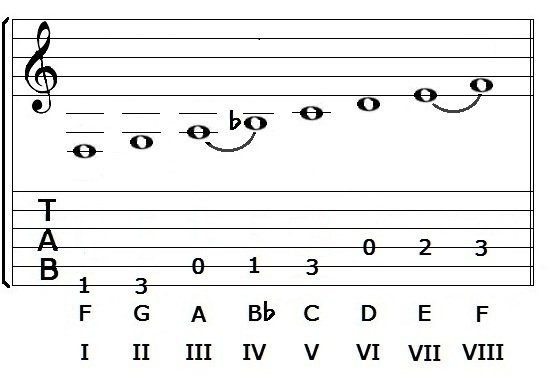
Check the scale you have written against the pattern of whole tones and semitones and you will see that there needs to be a whole tone between the fourth and fifth notes and a semitone between the third and fourth notes so the B needs to be lowered to Bb to fit the pattern correctly.
Instead of writing a flat in front of every B in a piece of music in F Major, the flat is usually written at the beginning of the staff right after the clef sign showing that ALL B’s in the piece of music no matter where they are on the staff must be flat. This is called a Key Signature.
This is the Key Signature of F Major.

SCALE OF Bb MAJOR:
To write the scale of Bb Major start at B and write a note on each line and in each space until you come back to B.
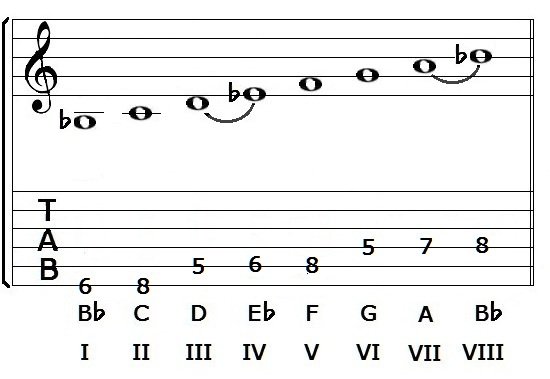
Check the scale you have written against the pattern of whole tones and semitones and
you will see that there needs to be a whole tone between the first and second notes so the
B needs to be lowered to Bb. There also needs to be a semitone between the third and
fourth notes and a whole tone between the fourth and fifth notes so the E needs to be
lowered to Eb.
This is the Key Signature of Bb Major.

SCALE OF Eb MAJOR:
To write the scale of Eb Major start at E and write a note on each line and in each space until you come back to E.

Check the scale you have written against the pattern of whole tones and semitones and
you will see that there needs to be three flats in order for it to fit into the pattern. The
scale of Eb Major will have Eb, Ab and Bb.
The Key Signature of Eb Major has three flats Eb, Ab and Bb as shown below.

SCALE OF Ab MAJOR:
To write the scale of Ab Major start at A and write a note on each line and in each space
until you come back to A.

Check the scale you have written against the pattern of whole tones and semitones and
you will see that there needs to be four flats in order for it to fit into the pattern. The
scale of Ab Major will have Ab, Bb, Db and Eb.
The Key Signature of Ab Major has four flats Ab, Bb, Db and Eb as shown below.

SCALE OF Db MAJOR:
To write the scale of Db Major start at D and write a note on each line and in each space
until you come back to D.

Check the scale you have written against the pattern of whole tones and semitones and
you will see that there needs to be five flats in order for it to fit into the pattern. The
scale of Db Major will have a Db, Eb, Gb Ab and Bb.
The Key Signature of Db Major has five flats Db, Eb, Gb Ab and Bb as shown below.

SCALE OF Gb MAJOR:
To write the scale of Gb Major start at G and write a note on each line and in each space
until you come back to G.
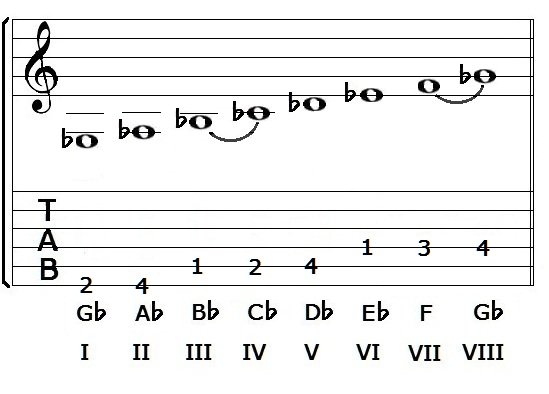
Check the scale you have written against the pattern of whole tones and semitones and
you will see that there needs to be six flats in order for it to fit into the pattern. The
scale of Gb Major will have a Gb, Ab, Bb, Cb, Db and Eb.
The Key Signature of Gb Major has six flats Gb, Ab, Bb, Cb, Db and Eb as shown
below.

SCALE OF Cb MAJOR:
To write the scale of Cb Major start at C and write a note on each line and in each space
until you come back to C.

Check the scale you have written against the pattern of whole tones and semitones and
you will see that there needs to be seven flats in order for it to fit into the pattern. The
scale of Cb Major will have a Cb, Db, Eb Fb, Gb, Ab and Bb.
The Key Signature of Cb Major has seven flats Cb, Db, Eb Fb, Gb, Ab and Bb as
shown below.

To sum up, here is a listing of keys and the number of flats that they have.
F Major = 1 Flat - Bb
Bb Major = 2 Flats - Bb, Eb
Eb Major = 3 Flats - Bb, Eb, Ab
Ab Major = 4 Flats - Bb, Eb, Ab, Db
Db Major = 5 Flats - Bb, Eb, Ab, Db, Gb
Gb Major = 6 Flats - Bb, Eb, Ab, Db, Gb, Cb
Cb Major = 7 Flats - Bb, Eb, Ab, Db, Gb, Cb, Fb
The way that I remember these keys and the order that they come in is by saying this little
Sentence: Charlie, Go Down And Eat Baked Fish, and I remember that it works in
reverse of the scales with sharps.
The flats on the keys always follow a certain order as well it is BEADGCF. It the revese
of the sharps. The way I remember this is with the sentence: Battle Ends And Down
Goes Charle’s Father.
I am hoping that as you read this some patterns are arising as well, for instance if you
count to the fourth or Sub Dominate note in the scale F Major, you will notice that the
fourth note in this scale is Bb. Bb Major is the next scale having two flats.
If you count to the fourth or Sub Dominate note in the scale Bb Major, you will notice
that the fourth note in this scale is Eb. Eb Major is the next scale having three flats.
If you count to the fourth or Sub Dominate note in the scale Eb Major, you will notice
that the fourth note in this scale is Ab. Ab Major is the next scale having four flats.
This holds true right up to Cb Major.
Another pattern you should notice is the patern on the guitar neck for the major scales
with flats.
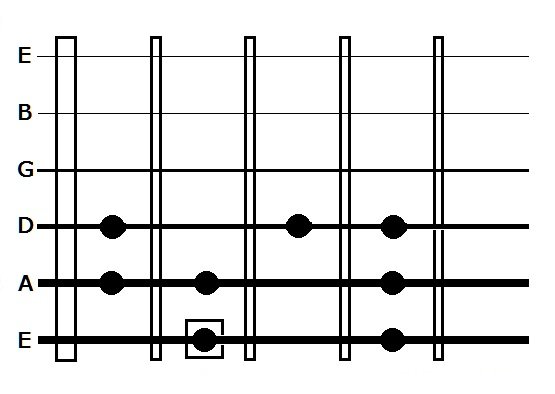
This pattern can be played anywhere on the neck of the guitar and the root or name of
the major scale is the dot with the square around it. So if you were to move this pattern
to where the dot with the square is on the first fret, you would be playing the scale F
Major. If you were to move this pattern to where the dot with the square is on the
sixth fret, you would be playing the scale Bb Major.
This pattern can also be extended to two octaves as below. It is a good idea to memorize
this pattern.
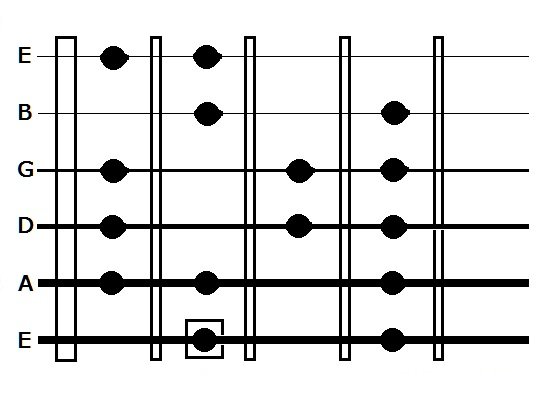
I will stop here and we will continue next week with lesson #6 – Minor Scales. Please comment or write questions below I will respond.